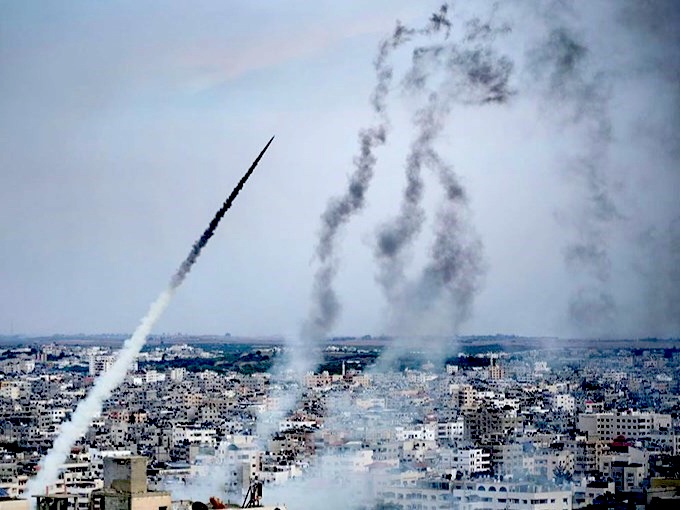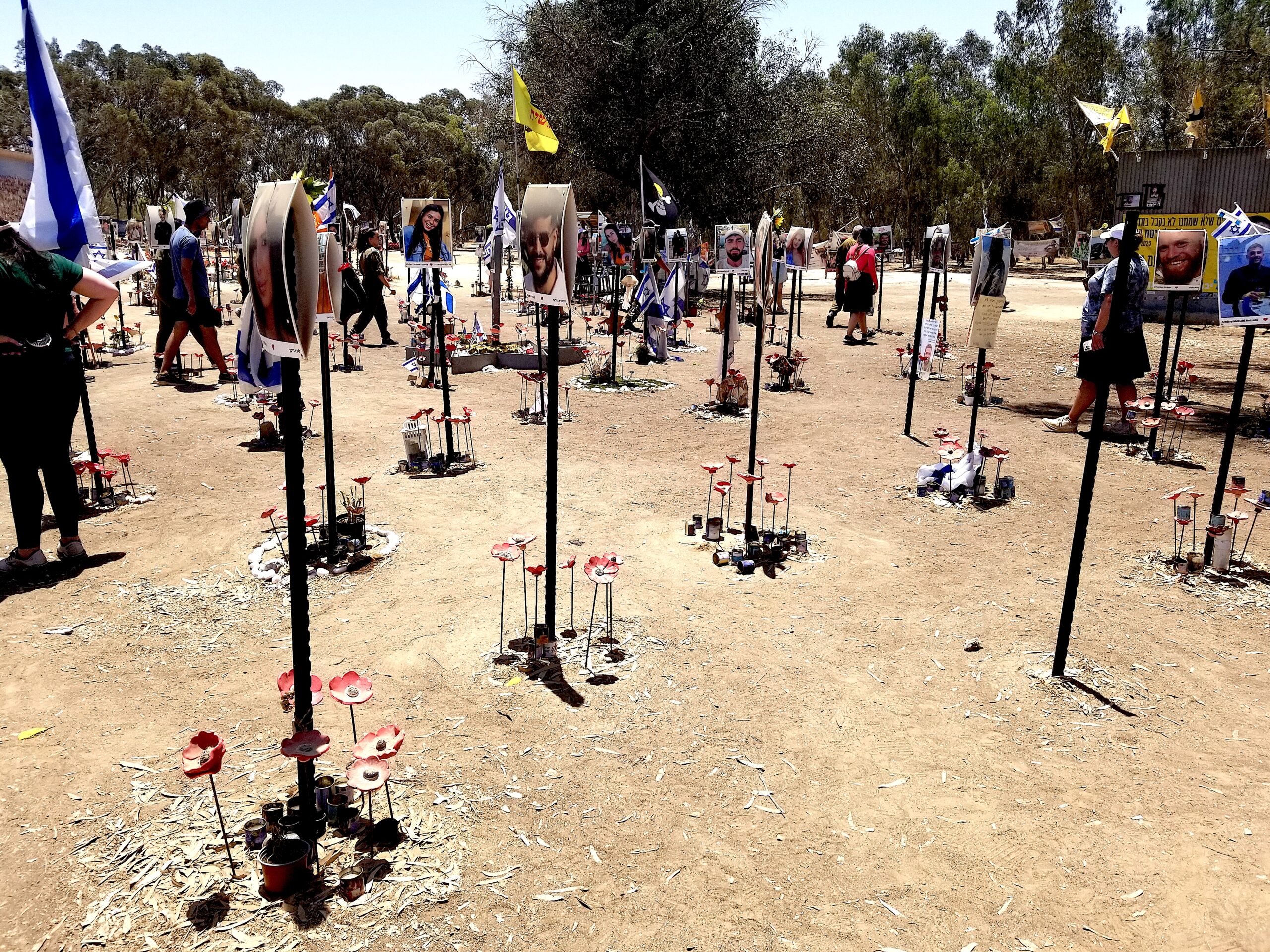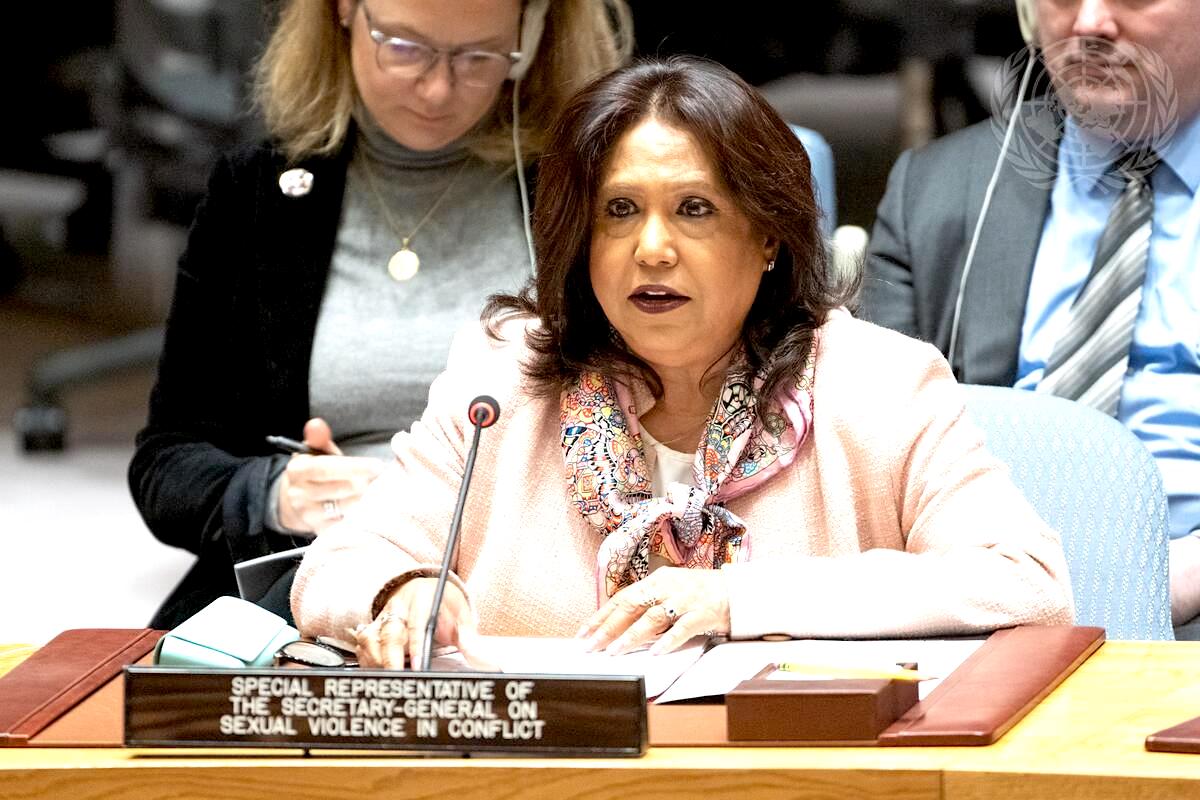While the overall picture of Oct. 7 has become clearer, an independent investigation is necessary to fully understand the events, writes Robert Inlakesh.

Hamas rocket attack from Gaza into Israel, Oct. 7, 2023. (Tasnim News Agency, Wikimedia Commons, CC BY 4.0)
By Robert Inlakesh
MintPress News
 It has now been one year since the Oct. 7 attack, led by Hamas’ al-Qassam Brigades. There are two diametrically opposed versions of that day: the Israeli narrative and what the evidence suggests.
It has now been one year since the Oct. 7 attack, led by Hamas’ al-Qassam Brigades. There are two diametrically opposed versions of that day: the Israeli narrative and what the evidence suggests.
On Oct. 7, at 6:30 a.m., the Qassam Brigades, the armed wing of Hamas, launched a military assault targeting Israeli military positions, Kibbutzim, and surrounding areas. According to a 16-page report issued by the group, titled “Our Narrative,” their stated mission was to attack Israeli military positions and seize captives to exchange for thousands of Palestinians held in Israeli prisons. The report also acknowledged certain “faults” in their actions.
[See: AS`AD AbuKHALIL: Hamas’ Official Account]
Israel’s narrative claims that an unprovoked terrorist attack was launched against them, deliberately targeting civilians, including allegations of beheadings, burning, and dismemberment of babies, as well as a premeditated mass rape campaign. U.S. Vice President Kamala Harris described the events as “the worst atrocity against the Jewish people since the Holocaust.”
The Death Toll
On Oct. 7, it was quickly reported that at least 413 Palestinians were killed in Israeli airstrikes across the Gaza Strip. However, the Israeli death toll underwent several revisions before an accurate figure emerged. Initially, the Israeli government stated that 1,400 Israelis had been killed. On Nov. 10, 2023, this number was revised down to “around 1,200,” with officials attributing the discrepancy to difficulties in differentiating between Israeli and Palestinian bodies due to severe burns.
The final Israeli death toll from the Oct. 7 attacks stands at 1,139, including 815 civilians and 324 soldiers, police, or security officers. This would suggest a civilian-to-combatant ratio of roughly 3.5:1, assuming all deaths were caused by Palestinian attackers.
Other accepted statistical breakdowns report 695 civilian deaths and 373 combatants, along with 71 foreigners. This highlights the ongoing debate over who should be classified as a civilian, as many off-duty soldiers and trained fighters took up arms during the attack, shifting their status from civilians to combatants.
The Resulting War on Gaza
According to a March 25 article written for Newsweek by John Spencer, chair of urban warfare studies at the Modern War Institute (MWI) at West Point, “Israel has created a new standard for urban warfare” in its war on Gaza. [Spencer suggested that Israel had achieved a historically low civilian-to-combatant ratio.] Israeli Prime Minister Benjamin Netanyahu later cited Spencer’s article during his speech to U.S. Congress in July.
Spencer’s argument is flawed, as he relies on Israeli ratio claims that don’t hold up when examining the official death toll in Gaza, particularly when accounting for the women and children killed. Spencer references the 2016-2017 Battle of Mosul in Iraq to justify what he deems an acceptable civilian-to-combatant ratio in U.S. wars, highlighting a 4:1 ratio where 10,000 civilians were killed for every 2,000 ISIS fighters.
Using this military logic and assuming Hamas was responsible for every Israeli death on Oct. 7, Israel achieved a more favorable civilian-to-combatant kill ratio than the U.S. did in Mosul.
Although this comparison may deviate from the core issue and is not an appropriate way to assess the events between Gaza and Israel, it is crucial to understand the logic behind the Israeli narrative about Oct. 7 and what it continues to justify today.
Who Killed Whom?

Kibbutz Be’eri four days after the Oct. 7, 2023, Hamas offensive. (Kobi Gideon / Government Press Office of Israel, CC BY-SA 3.0)
The Oct. 7 assault began with a breach of the Separation Fence between the Gaza Strip and Israel, as rockets were launched to provide cover for Hamas fighters using paragliders. Suicide drones also targeted Israeli army monitoring equipment and automatic machine gun towers.
The attack, which Hamas named Operation Al-Aqsa Flood, initially targeted a series of military bases, outposts, and Israeli soldiers stationed at the Erez/Beit Hanoun Crossing. However, it also struck Israeli kibbutzim, or settler communities, located around the Gaza periphery.
Various other civilian sites were also attacked, most notably the Nova Music Festival, where hundreds were reportedly killed. According to the Israeli narrative, Hamas intentionally targeted the festival. This account was echoed in a recent BBC documentary titled We Will Dance Again, which aligns with Israel’s version of events. The documentary’s director, Yariv Mozer, commented on the Nova Festival attack, reinforcing this interpretation:
“A brutal fundamentalistic movement [Hamas] is obsessively looking to destroy the values of Western society. These were young people at a music festival celebrating life, love, and peace: very naïve and free-spirited. And they faced the most horrific people, who value death.”
However, as early as November, Israeli police reports concluded that Hamas had not initially planned to target the Nova Festival, with their primary objective being a nearby kibbutz, Re’im.
Israel’s Channel 12 published findings from the first report, which included information from Hamas documents and interrogations. According to these sources, Hamas fighters only became aware of the festival during the operation and entered the grounds from a nearby highway.
According to a report published by the Israeli daily Haaretz, police analysis found that most partygoers had fled the Nova Festival approximately half an hour before any gunfire was heard. Additionally, the report indicated that an Israeli military helicopter had opened fire, resulting in the deaths of some festival participants.

Memorial of those murdered on Oct. 7, 2023, at the Nova Music Festival. (Relspas, Wikimedia Commons, CC BY-SA 4.0)
A United Nations human rights report, released on June 12, confirmed “the presence of at least eight attack helicopters in various locations” and noted that it was aware of reports suggesting these helicopters had been used to attack civilian vehicles at the festival site. The report further stated:
“The Commission found that Israeli authorities prioritised identifying victims, notifying families and allowing for burial rather than forensic investigation, leading to evidence of crimes, especially sexual crimes, not being collected and preserved. The Commission also notes the loss of potential evidence due to inadequately trained first responders.”
An investigation published in Yediot Aharonot in January concluded that at least 70 vehicles were destroyed by Israeli tank, drone, or helicopter fire, following orders from senior Israeli military command to prevent the capture of hostages “at any cost.”
In December 2023, footage surfaced showing an Israeli tank firing on a civilian home in Kibbutz Be’eri. It was later confirmed that Israeli forces were responsible for the deaths of 13 Israeli civilians in that incident, further supporting these revelations.

ZAKA volunteers working in Be’eri kibbutz in October 2023. (Tomer Persico, Wikimedia Commons, CC BY-SA 3.0)
Several videos show Hamas fighters engaging in violent actions within civilian areas, including indiscriminate firing, killing non-combatants, and throwing grenades into shelters. This evidence highlights instances of violence, but it does not conclusively prove that these actions were part of a broader premeditated strategy.
There is still no definitive evidence regarding the full extent of responsibility for the majority of civilian deaths that occurred on Oct. 7.
Another important consideration is that Hamas was not the only group involved in breaching the Gaza separation fence on Oct. 7. At least five different Palestinian resistance groups reportedly followed suit, targeting Israeli military sites and settlements.
It is estimated that over 4,000 people crossed the fence that day. While Hamas led the mission, it remains unclear how many Israeli deaths were caused by fighters from these other armed groups.
A ‘Mass Hannibal’ Event?
Despite the questions raised by outlets such as The Cradle and the investigative articles published by Mondoweiss, the Electronic Intifada and The Grayzone — which pointed to Israel’s infamous Hannibal Directive as a potential factor — this body of work has largely been dismissed and labeled as conspiracy theories.
It is important to note that the Hannibal Directive, a controversial Israeli military order designed to prevent the capture of soldiers — even if it means killing them — was acknowledged by Israeli Air Force Colonel Nof Erez in December 2023.
He referred to Oct. 7 as a “mass Hannibal” event. However, widespread acceptance of Israel’s implementation of the Hannibal Directive on that day only came after Israel’s Haaretz published a detailed article on July 7.
The bombshell Haaretz article, citing army sources, was released just before the results of an internal Israeli military investigation into the events of Oct. 7 were published. The investigation confirmed that the Hannibal Directive had been triggered that day.
However, the official probe contained several inconsistencies, including a claim that Israeli tank fire did not kill any civilians at Kibbutz Be’eri. This assertion was later debunked by eyewitness accounts, forensic analysis, and video evidence, casting doubt on the investigation’s credibility and raising concerns about accountability within Israeli forces.
A recent investigation by ABC News effectively compiled all relevant information from Israeli sources regarding Israel’s use of the Hannibal Directive. The report laid to rest any doubts that the directive had not been implemented on a large scale, providing clear evidence that it played a significant role in the events of Oct. 7.
40 Beheaded Babies
Israeli media, government officials, and their Western counterparts have repeatedly circulated several unverified claims about the events of Oct. 7. These included allegations such as the beheading of 40 babies, infants being hung on clothing lines, and a pregnant woman whose baby was reportedly cut from her womb.
Many of these stories were initially promoted by Israel’s ZAKA rescue agency, which has faced its own controversies, including corruption allegations. The organization was founded by Yehuda Meshi-Zahav, who has been accused of serious criminal offenses.
According to confirmed reports, one baby tragically died on Oct. 7, killed by a bullet during crossfire. Other claims regarding babies have been debunked.
During Israeli Prime Minister Benjamin Netanyahu’s July address to the U.S. Congress, he introduced a new narrative about Oct. 7, claiming that two children hid in a basement only to be murdered by Hamas fighters. However, no record or evidence substantiates this claim, and no children matching the description have been reported.

Netanyahu addressing a joint session of U.S. Congress on July 24. (C-Span screen shot)
There have also been allegations of a mass rape campaign carried out by Hamas on Oct. 7, which have been featured in documentaries like Sheryl Sandberg’s Screams Before Silence. The documentary presents interrogation tapes from the Shin Bet as evidence of these claims.
However, serious investigations have dismissed these tapes, as they were reportedly recorded under conditions of torture, making them unreliable sources of evidence.
Despite widespread reports from mainstream media outlets in the West that mass rapes occurred on Oct. 7, Israeli police have not been able to verify any of the alleged incidents. There is currently no forensic evidence, documented intent, identified victims, or credible witnesses supporting these claims.
The largest investigation into the Hamas rape allegations, published by The New York Times, became controversial when the family of a woman cited as a central case in the story publicly refuted the claims. The article quickly became the subject of a scandal, further casting doubt on the validity of the allegations.
[See: Patrick Lawrence: Crisis at the NYT]
Praised across the media, an Israeli lawyer named Cochav Elkayam-Levy established what she was calling a “civilian commission” to investigate the Hamas rape campaign. Yet, despite all the positive press, she was later exposed for sharing countless fake rape stories and soliciting millions of dollars for a commission, of which she was the only member.
This led to a number of Israeli government officials publicly distancing themselves from her and accusing her of “inaccurate” research.
At the request of the Israeli government, U.N. Special Representative Pramila Patten undertook an eight-day mission to gather evidence of sexual violence allegedly committed on Oct. 7.
This effort culminated in a report summarizing the findings. Although the nine U.N. experts involved in the trip did not have an official investigative mandate, they released some key observations from their visit.

Patten briefing the Security Council on March 11. (UN Photo/Eskinder Debebe)
The U.N. report concluded that Israelis were “subjected to various forms of conflict-related sexual violence,” though it stopped short of providing definitive conclusions. Instead, it stated that such incidents were possible. Notably, the report debunked two specific allegations as “unfounded.”
One involved a woman reportedly found separated from her family with her pants pulled down. The investigation determined that a bomb squad had altered the “crime scene, and the bodies moved,” leading to uncertainty about the details of the alleged incident.
What The Evidence Says
The Hamas-led Oct. 7 attack remains one of the most politicized events in recent history, with its details being used to justify the ongoing violence in Gaza. The facts surrounding the incident are still being debated, with various narratives continuing to twist the specifics of what occurred that day.
What is clear is that Hamas launched a coordinated military campaign on Oct. 7, with the involvement of at least five other Palestinian resistance groups. The attack targeted Israeli military positions and settlement areas with the stated objectives of striking Israel’s southern command and capturing individuals to exchange for Palestinian detainees.
During the course of these operations, intense firefights ensued, and numerous violations of international law were likely committed.
Many extreme claims about Oct. 7, such as those involving babies and decapitated women, have been debunked. Verified cases of killings with light weapons occurred, and Israel’s invocation of the Hannibal Directive led to civilian deaths.
While it’s difficult to determine how many were killed by Israeli forces versus Palestinian groups, the scale of destruction suggests Israel was responsible for a significant portion of the casualties.
Allegations of sexual violence on Oct. 7 remain unproven. While individual cases may have occurred, no evidence supports claims of an orchestrated mass rape campaign. Investigations have not confirmed any specific cases but suggest such crimes could have occurred.
While the overall picture of Oct. 7 has become clearer, an independent investigation is necessary to fully understand the events.
Israel has blocked such an inquiry and destroyed evidence, likely fearing it would reveal inconvenient truths that could undermine what little public support remains for its ongoing military operations in Gaza, the West Bank and Lebanon.
Robert Inlakesh is a political analyst, journalist and documentary filmmaker currently based in London. He has reported from and lived in the occupied Palestinian territories and hosts the show “Palestine Files.” Director of “Steal of the Century: Trump’s Palestine-Israel Catastrophe.” Follow him on Twitter @falasteen47
This article is from MPN.news, an award winning investigative newsroom. Sign up for their newsletter.
The views expressed are solely those of the author and may or may not reflect those of Consortium News.
Please Donate Today to CN’s Fall Fund Drive



The author begins his article by stating, accurately, and thus clarifying the discussion at the outset, that the 7 October attack was launched by “the Qassam Brigades, the armed wing of Hamas”. This is crucial because Hamas is MUCH more than its armed wing, and there is no evidence, much less proof, that the civil administration agencies of Hamas were involved in any way in the attack.
However, throughout the rest of the article, the author repeatedly uses the simple term “Hamas”, exactly as do the Western corporate media, which are notorious for their utter lack of nuance. It is precisely this amalgamation that is constantly being used by the Israelis to justify the destruction of any and all locations touched by the civil administration in Gaza, including hospitals, schools and the bureau of vital statistics.
If Mr Inkalesh indeed “has reported from and lived in the occupied Palestinian territories” he can/should do better.
As diligent investigative reporters of the alt media have pointed out, there is little, if any, evidence for the frenzied claims of mass baby killing and rape by Hamas. But even if there were, why would the civilian population be considered just as guilty?
The U.S. is a not so shining example for mass shootings. And we’re #1 in serial killers, too. So then should all Americans, regardless of age, gender, race, or class be considered dangerous criminals deserving eradication? How then could we think that is ever okay for others?
First Things first. I hit the hot link to sign up for the newsletter. I got and error something about a blank address.
I have monitored the relationship between the U.S. Government and Israel since before I got drafted. The USS Liberty event put my young ass on alert! I have always been critical, from day one.
Unfortunately, I expected the actual course of events having occurred since October 7, 2023 to play out almost exactly as reported here by Robert Inlakesh via the MintPress News. And reported rather well with documentation. My instincts about low-life are pretty good.
Israeli government lies are their modes operandi, it’s all about a deception habit it, much like the one the U.S. Government has an addiction to. All inclusive deceit from the highest levels of government. This is an all too real threat to free people everywhere on this planet! Hell, what could go wrong!
I intend to go right to my U.S. Senator after leaving here. I advise everyone else to do the same and give our “leadership’ a huge ration of grief about at least this one thing.
Earlier today a viewed and short clip of POTUS “Joey Biden” using the F-bomb describing , well in his words “that fucking Putin is Evil”. Seems the POTUS has found himself solidly trapped between a rock ( – Iraq is spinning in my mind as a pun I’d love to make, but I regress -) and a very hard place. The rock being of course what resides inside Bibbi’s skull and the hard place being Russia’s Putin. No rocks to be found in his head, just
determination to give the U.S. and NATO as much hell as he can.
He was an intelligence agent Joey not Trump!
Any how I have had just about enough of the Zionist leaning NEOCON mentality of “Joey’s” Bull crap !
Saying Putin is Evil and kissing bibbi’s ass defies any logical thought or rational . What goes for one goes for the other unless of course you happen to be a Zionist leaning NEOCON who has just said the quiet part out loud.
Dog give me strength! I’m not at all sure the POTUS’s short wired brain will make it to the upcoming election.
Guy has gotten this quite correctly.
Thanks CN
Truth is always the first casualty of war .When it relates to zionist Israel and the lessons we have learned since 1948 and before,the history speaks for itself .
Well said “Guy”!
And thanks to CN for publishing these informative and needed factual updates; especially considering the corrections of debunked lies and false attributions of heinous crimes.
As Usual,
EA